Elevate Your Go App with DevOps Practises: The Ultimate Guide to Streamlined Deployment
 Sujith Sai
Sujith SaiTable of contents
- Introduction:
- Project Overview:
- Running the application Locally
- Step-1: Containerizing the application
- Step-2: Kubernetes Manifests
- Step-3:Creating an EKS Cluster
- Step-4 Create an ingress controller
- Step-5 Helm chart creation:
- Step-6 Continuous Integration using GitHub Actions
- Step-7 CD using ArgoCD
- Conclusion:
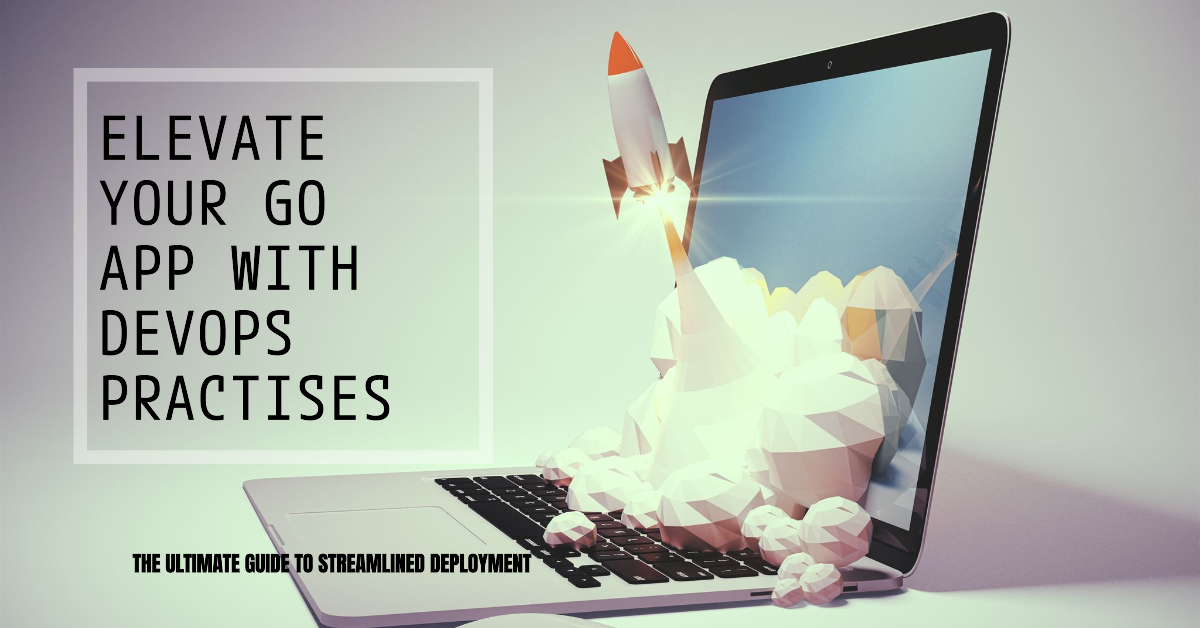
Introduction:
In the rapidly evolving software development world, efficient application deployment and management are key to success. This project showcases the transformation of a Go application into a highly automated, scalable, and maintainable system using advanced DevOps practices. The goal is to optimize the development workflow and ensure smooth integration and delivery through state-of-the-art tools and techniques
Project Overview:
Application Analysis and Local Setup:
- Start by examining the Go application’s structure and running it locally. This step helps in understanding its dependencies and configurations, which are crucial for creating an effective Docker container.
Containerization:
- Develop a streamlined Docker image using a multi-stage Dockerfile, which separates the build and runtime environments. This approach results in a lightweight and secure image.
Kubernetes Deployment:
- Create Kubernetes manifests to manage the deployment, service, and ingress of the application. Deploy these manifests on an AWS EKS cluster to ensure scalability and high availability.
Ingress Setup:
- Implement an Nginx ingress controller to handle external access
Helm Chart Development:
- Build a Helm chart to facilitate configuration and deployment across various environments, such as development and production. This approach simplifies the management of environment-specific settings.
Continuous Integration with GitHub Actions:
- Configure a GitHub Actions CI pipeline to automate the build, test, and deployment processes. This setup ensures that every code change is automatically tested and deployed, maintaining high code quality.
Continuous Delivery with ArgoCD:
Integrate ArgoCD for continuous delivery, providing a robust interface for managing and monitoring deployments. ArgoCD automatically deploys updates to the Kubernetes cluster when changes are detected.

Running the application Locally
Before deploying the application with DevOps practices, it’s essential to verify that the Go application runs correctly on your local machine.
Clone the go lang application repository from GitHub by running the below command
git clone https://github.com/iam-veeramalla/go-web-app
cd go-web-app
Running the server:
To run the server, execute the following command:
go run main.go
You can access it by navigating to http://localhost:8080/courses in your web browser.
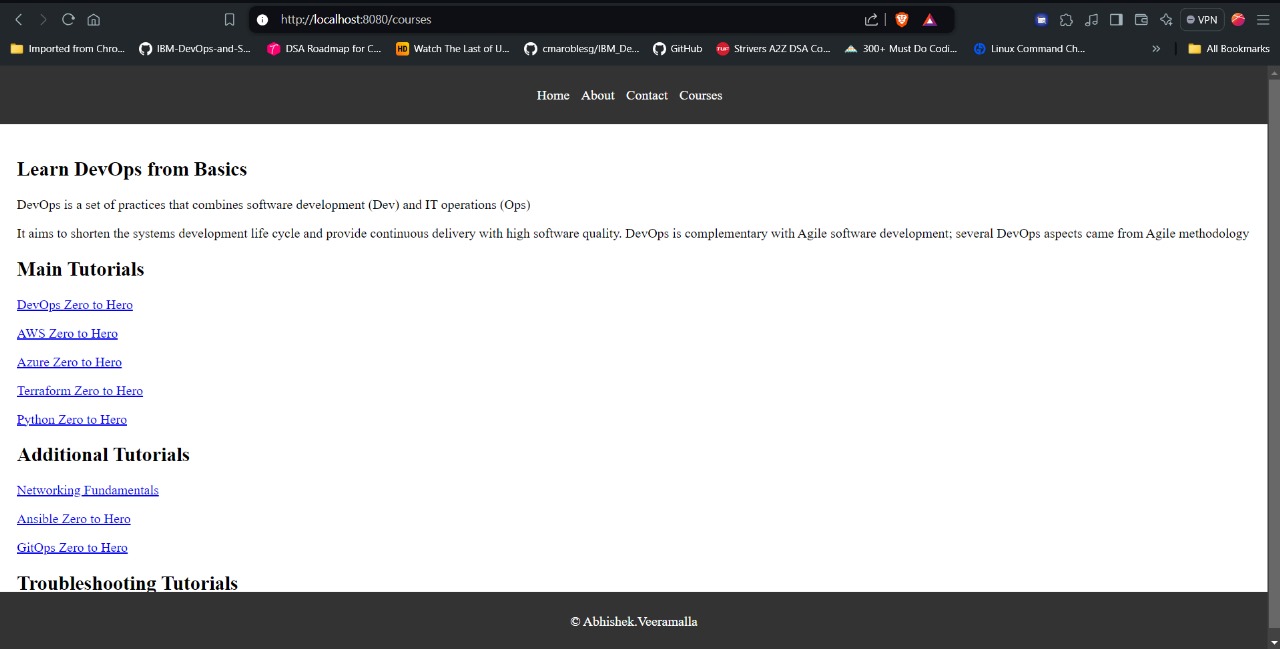
Now lets apply all the devops practises on this go lang application.
Step-1: Containerizing the application
lets write a multi stage docker file and build the docker image for this go lang application
FROM golang:1.22.5 AS builder
WORKDIR /app
COPY go.mod .
RUN go mod download
COPY . .
RUN go build -o main .
FROM gcr.io/distroless/base
COPY --from=builder /app/main .
COPY --from=builder /app/static ./static
EXPOSE 8080
CMD ["./main"]
Lets break down the dockerfile:
FROM golang:1.22.5 AS builder: This specifies the base image for the first stage of the build. It uses thegolangimage with version1.22.5WORKDIR /app: Sets the working directory inside the container to/app.COPY go.mod .: Copies thego.modfile from your local machine into the/appdirectory in the container.RUN go mod download: Downloads the Go module dependencies specified ingo.mod.COPY . .: Copies the rest of the application code from your local machine into the/appdirectory in the container.RUN go build -o main .: Builds the Go application. The-o mainflag specifies that the output binary should be namedmain.FROMgcr.io/distroless/base: Specifies the base image for the second stage of the build.gcr.io/distroless/baseis a minimal base image provided by Google that contains only the runtime libraries needed to run the application, but not the package manager or shell.COPY --from=builder /app/main .: Copies themainbinary from thebuilderstage into the current directory (.) of this stage.COPY --from=builder /app/static ./static: Copies thestaticdirectory from thebuilderstage into the./staticdirectory of this stage.EXPOSE 8080: Documents that the application will listen on port8080CMD ["./main"]: Sets the default command to run when a container is started from this image. In this case, it runs themainbinary built earlier.
Now lets build and push it to the dockerhub
To build and push the docker image follow the below command
docker build -t "your_dockerhub_username"/go-web-app:1
Log In to Docker Hub
Before pushing the image, you need to log in to Docker Hub.
docker login
Push the docker image to the dockerhub
docker push "your_dockerhub_username"/go-web-app:1
Step-2: Kubernetes Manifests
Create a deployment.yml file
apiVersion: apps/v1
kind: Deployment
metadata:
name: go-web-app
labels:
app: go-web-app
spec:
replicas: 1
selector:
matchLabels:
app: go-web-app
template:
metadata:
labels:
app: go-web-app
spec:
containers:
- name: go-web-app
image: sujithsai/go-web-app:1
ports:
- containerPort: 8080
This deployment manifest defines a Kubernetes Deployment resource, which is responsible for managing a set of identical application pods.
Create a service.yml file
apiVersion: v1
kind: Service
metadata:
name: go-web-app
labels:
app: go-web-app
spec:
ports:
- port: 80
targetPort: 8080
protocol: TCP
selector:
app: go-web-app
type: NodePort
his service manifest defines a Kubernetes Service resource, which serves several critical functions for managing and accessing deployed pods:
Load Balancing: Distributes incoming traffic evenly across the pods that match the specified label (
app: go-web-app), ensuring balanced load distribution.Port Mapping: Configures the service to expose an external port (
80) and map it to the target port (8080) on the pods.Service Type (NodePort): Allows external access to the service from outside the Kubernetes cluster via a specific port on each node
Create a ingress.yml
apiVersion: networking.k8s.io/v1
kind: Ingress
metadata:
name: go-web-app
annotations:
nginx.ingress.kubernetes.io/rewrite-target: /
spec:
ingressClassName: nginx
rules:
- host:
http:
paths:
- path: /
pathType: Prefix
backend:
service:
name: go-web-app
port:
number: 80
With Ingress, users create an Ingress resource, and cloud providers offer Ingress controllers. These controllers work with different load balancer solutions to provide advanced features like path-based routing, SSL termination, and better resource use.
here in our case we are using nginx as loadbalancer.
Step-3:Creating an EKS Cluster
Before getting started, we need to install some essential tools to interact with AWS EKS.
kubectl: Follow this documentation to install the appropriate kubectl version based on your system specifications.
eksctl: eksctl is a command-line interface for interacting with EKS clusters. Follow this installation guide to install and configure it.
AWS CLI: AWS CLI is a command-line interface for interacting with your AWS account. Follow this guide to install and configure it.
Now lets create an eks cluster, to create an eks cluster using aws cli follow the below command.
eksctl create cluster --name go-web-app --region us-east-1
The created cluster is of EC2 type and not fargate, so EC2 instances will be created by EKS in the same region(us-east-1)
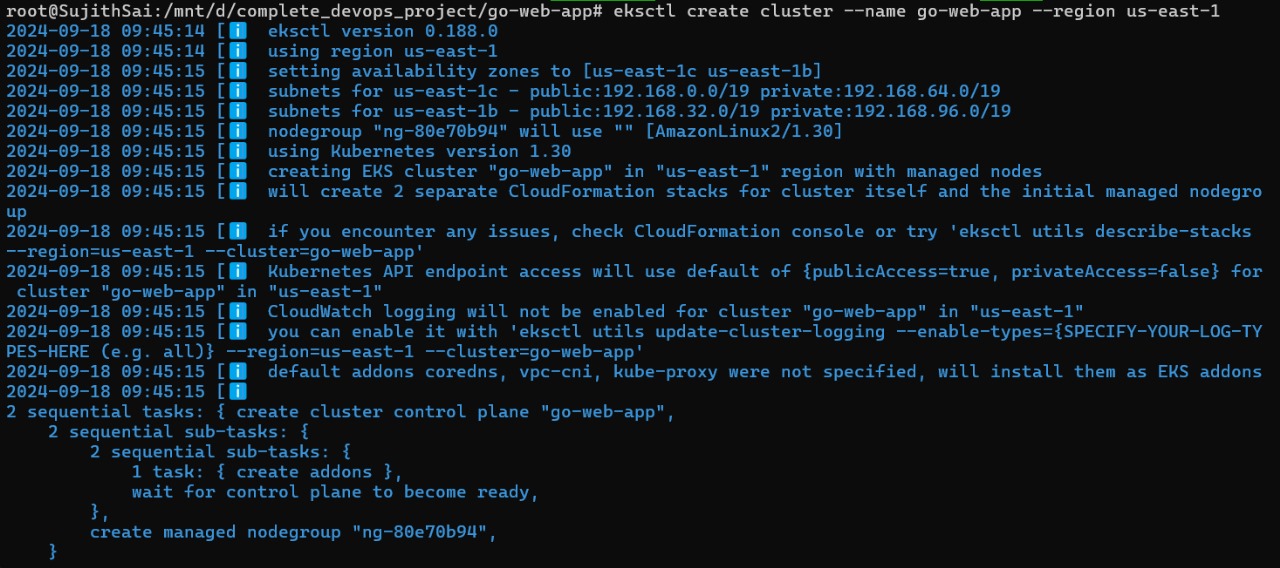
Next apply all the kubernetes manifests that we created by using the below command
kubectl apply -f deployment.yml
kubectl apply -f service.yml
kubectl apply -f ingress.yml

you can verify using the below command
kubectl get all

Step-4 Create an ingress controller
Since we are deploying on AWS EKS and need to access the application from outside, we need to create a LoadBalancer. We will be using an NGINX Ingress Controller for this purpose. You can use any other LoadBalancer or Ingress Controller of your choice if preferred.
now lets install the load balancer,run the below command..
kubectl apply -fhttps://raw.githubusercontent.com/kubernetes/ingress-nginx/controller-v1.11.1/deploy/static/provider/aws/deploy.yaml
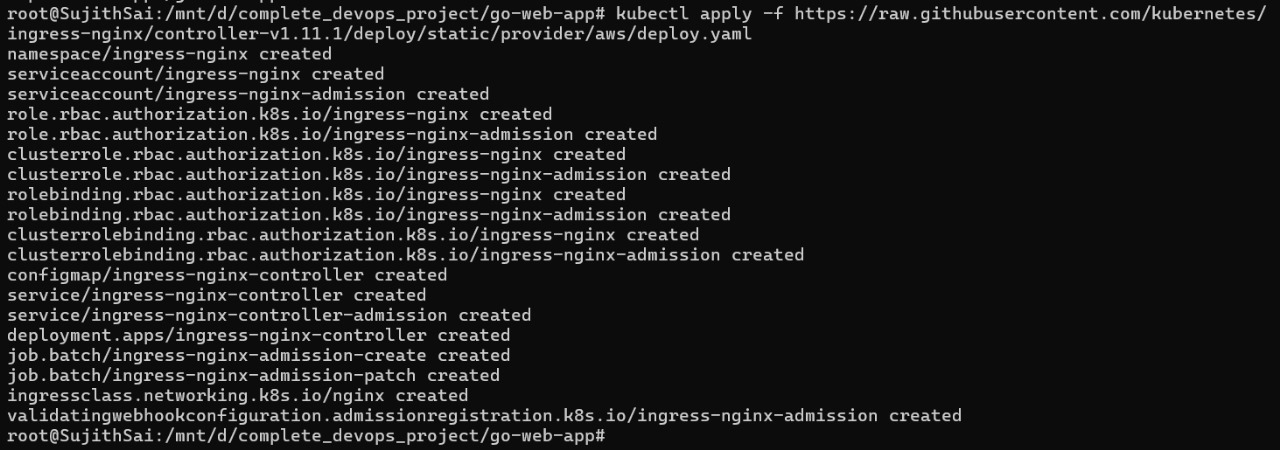
Now that we have created all the necessary Kubernetes manifests to deploy our application on the Kubernetes cluster and access it from the outside world, you can access the application by running the following command and copying the address:
kubectl get ingress

access the application using the above address/courses
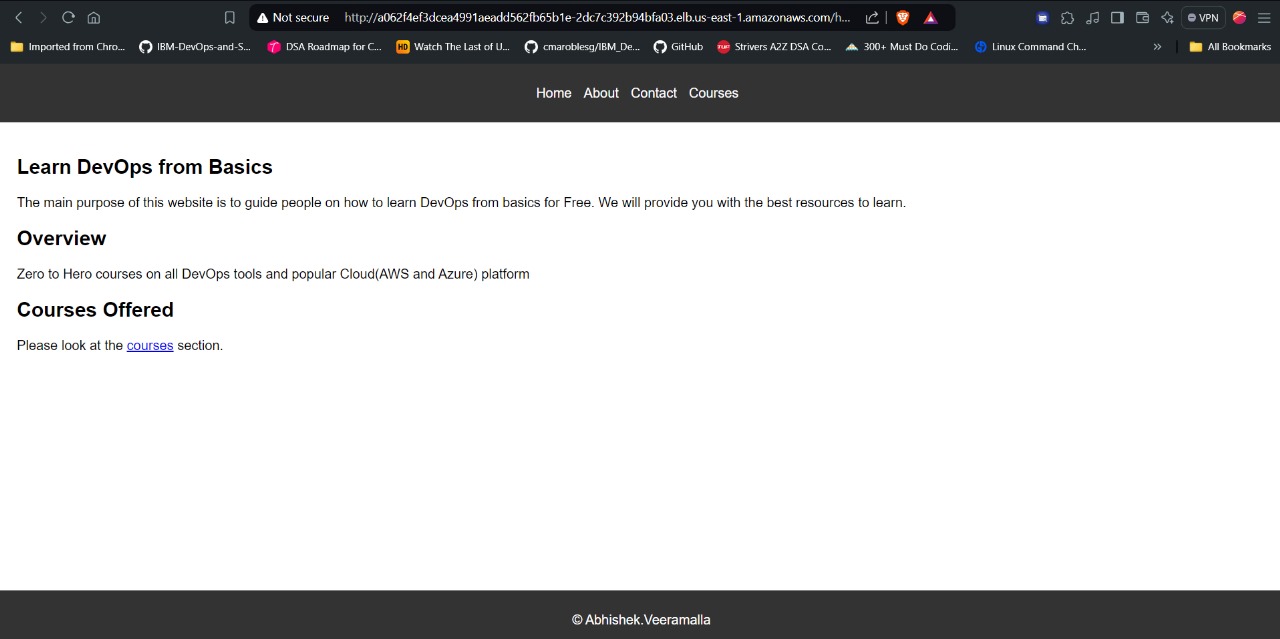
Step-5 Helm chart creation:
The concept of Helm is designed to simplify the deployment of applications across different environments, such as development, production, and testing. Typically, you might create separate Kubernetes manifests for each environment, but this process is inefficient and time-consuming. To solve this problem, instead of writing individual Kubernetes manifests for each stage, we create a Helm chart and pass environment-specific values. This approach is universal and works for all stages, making the deployment process more streamlined and manageable.
create helm using the following command
helm create go-web-app-chart

Now, copy all the Kubernetes manifest files to the templates folder in the go-web-app-chart. You can do this with the following command:
cd templates
cp ../../kubernetes/manifests/* .

Update values.yaml according to our manifests
# Default values for go-web-app-chart.
# This is a YAML-formatted file.
# Declare variables to be passed into your templates.
replicaCount: 1
image:
repository: sujithsai/go-web-app
pullPolicy: IfNotPresent
# Overrides the image tag whose default is the chart appVersion.
tag: ""
ingress:
enabled: false
className: ""
annotations: {}
# kubernetes.io/ingress.class: nginx
# kubernetes.io/tls-acme: "true"
hosts:
- host: chart-example.local
paths:
- path: /
pathType: ImplementationSpecific
Now update the deployment.yml file as shown below
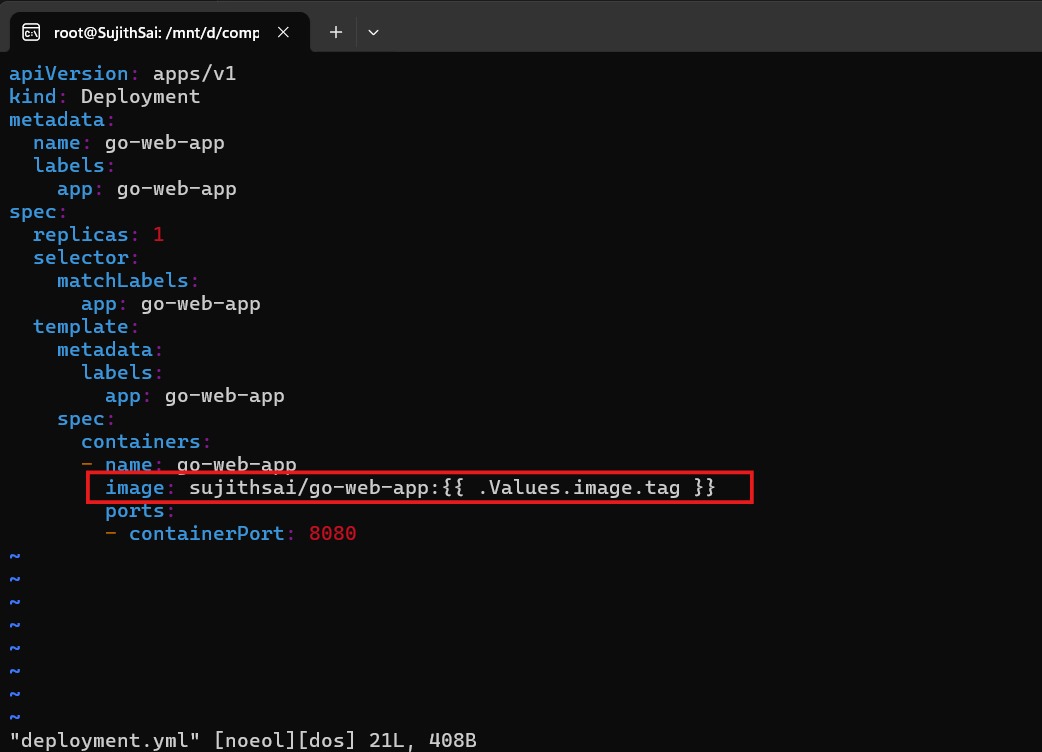
The above change indicates that it refers to the values.yaml file in the go-web-app-chart folder and accesses the image using the “tag” field.
Now lets delete all the resources and re install using helm
kubectl delete deploy go-web-app
kubectl delete svc go-web-app
kubectl delete ing go-web-app
Verify

Go back to the main helm directory and install it using below command
helm install go-web-app ./go-web-app-chart

Verify the creation.

All the resources are created as mentioned in the templates and helm is working, so uninstall all the resources again.
helm uninstall go-web-app-chart
Step-6 Continuous Integration using GitHub Actions
Create a folder .github/workflows
Before creating the ci.yml file, you need to add the required credentials to the repository's secrets.
You will need:
Docker credentials to push the built Docker image.
GitHub credentials to update the Helm values.
To add these credentials, follow these steps:
Navigate to the repository's Settings.
Go to Secrets and variables.
Select Actions secrets.
Store all the required credentials here.Similarly add “DOCKERHUB_TOKEN” and “TOKEN”(Github token”)
Now create a ci.yml file
# CICD using GitHub actions
name: CI/CD
# Exclude the workflow to run on changes to the helm chart
on:
push:
branches:
- main
paths-ignore:
- 'go-web-app-chart/**'
- 'kubernetes/**'
- 'README.md'
jobs:
build:
runs-on: ubuntu-latest
steps:
- name: Checkout repository
uses: actions/checkout@v4
- name: Set up Go 1.22
uses: actions/setup-go@v2
with:
go-version: 1.22
- name: Build
run: go build -o go-web-app
- name: Test
run: go test ./...
code-quality:
runs-on: ubuntu-latest
steps:
- name: Checkout repository
uses: actions/checkout@v4
- name: Run golangci-lint
uses: golangci/golangci-lint-action@v6
with:
version: v1.56.2
push:
runs-on: ubuntu-latest
needs: build
steps:
- name: Checkout repository
uses: actions/checkout@v4
- name: Set up Docker Buildx
uses: docker/setup-buildx-action@v1
- name: Login to DockerHub
uses: docker/login-action@v3
with:
username: ${{ secrets.DOCKERHUB_USERNAME }}
password: ${{ secrets.DOCKERHUB_TOKEN }}
- name: Build and Push action
uses: docker/build-push-action@v6
with:
context: .
file: ./Dockerfile
push: true
tags: ${{ secrets.DOCKERHUB_USERNAME }}/go-web-app:${{github.run_id}}
update-newtag-in-helm-chart:
runs-on: ubuntu-latest
needs: push
steps:
- name: Checkout repository
uses: actions/checkout@v4
with:
token: ${{ secrets.TOKEN }}
- name: Update tag in Helm chart
run: |
sed -i 's/tag: .*/tag: "${{github.run_id}}"/' go-web-app-chart/values.yaml
- name: Commit and push changes
run: |
git config --global user.email "sujithsai.sirimalla33@gmail.com"
git config --global user.name "Sujithsai08"
git add go-web-app-chart/values.yaml
git commit -m "Update tag in Helm chart"
git push
Breakdown of the above ci.yml file
The CI workflow is triggered when somebody pushes to repository however it ignores any pushes made to “Readme”,”kubernetes”,”go-web-app-chart” folders
Stage 1 - Build and Unit Test:
In this job, the application code is checked out, the Go environment is set up, the application is built, and tests are run.
Stage 2 - Static Code Analysis:
In this job,
golangci-lintis used to ensure code quality.Stage 3 - Building Docker Image and Pushing to Docker Hub:
In this job, a Docker image is built from the repository and pushed to Docker Hub using the credentials stored as secrets in the repository.
Stage 4 - Update Tag in Helm Chart:
In this job, the "tag" in the Helm chart values is updated with the GitHub unique runner ID and the changes are pushed to the github repo with the given credentials
Now, push the changes to your repository to run the ci.yml.
Once the push is done, GitHub will automatically trigger the workflow.
Verify the continuous integration using GitHub Actions.
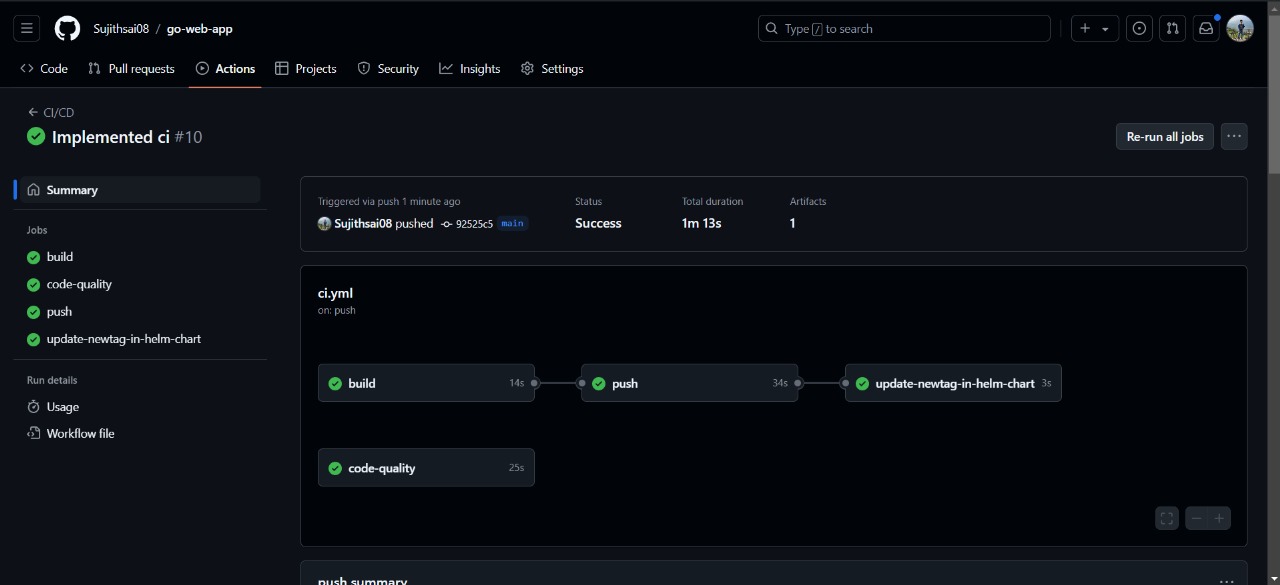
next verify the docker image that is pushed into dockerhub by ci.yml
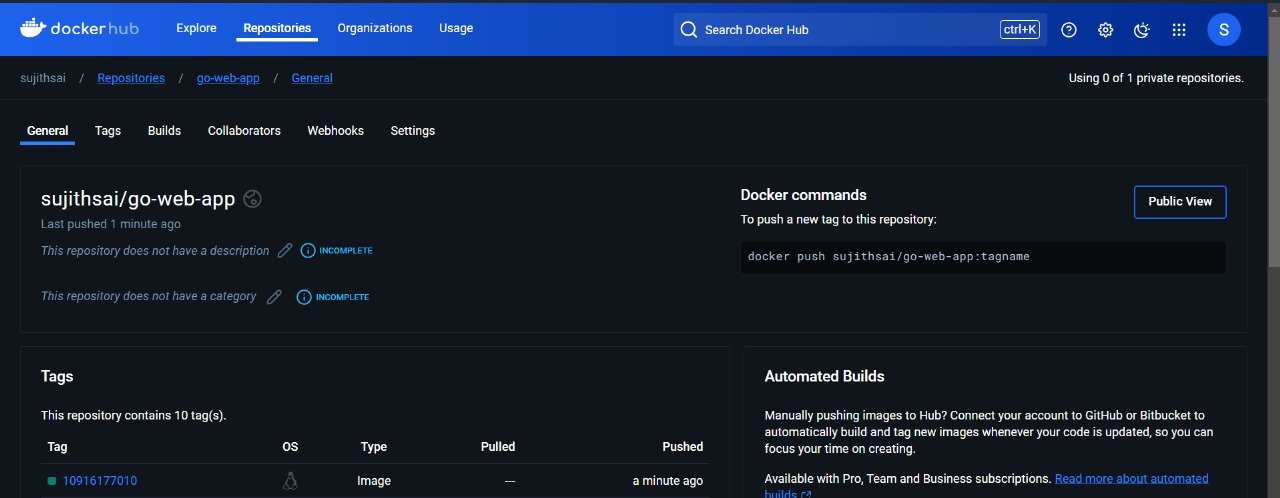
next verify the image tag name in the values.yaml file
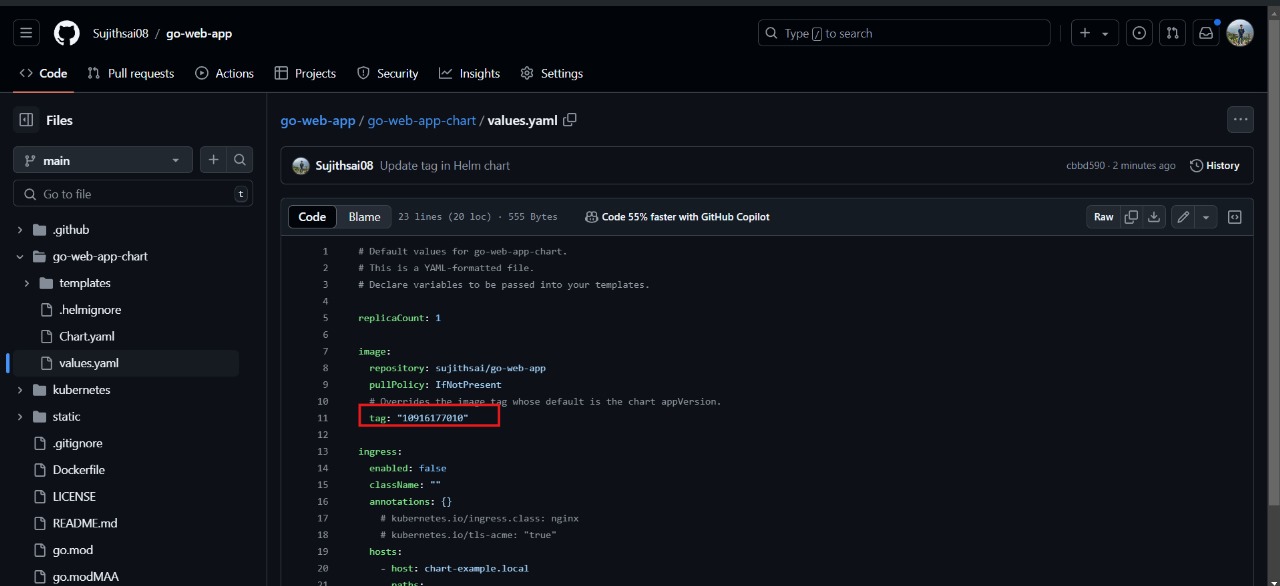
As you can see, the new Docker image tag that was pushed to Docker Hub has also been updated in the values.yaml file.
Step-7 CD using ArgoCD
install argocd by using below command:
kubectl create namespace argocd
kubectl apply -n argocd -f https://raw.githubusercontent.com/argoproj/argo-cd/stable/manifests/install.yaml
Accessing the argocd ui(as a loadbalancer)
apply the below command
kubectl patch svc argocd-server -n argocd -p '{"spec": {"type": "LoadBalancer"}}'

Access the ArgoCD UI using the external IP address. You can find it by using the command below:
kubectl get svc -n argocd

Copy the external IP address and paste it into your browser to access the ArgoCD UI.
Now Get the password using
kubectl edit argocd-intial-admin-secret -n argocd
The password you obtained is encoded with base64, so we need to decode it in order to log in to the ArgoCD UI.
To decode the password, use the following command:
echo "password" | base64 --decode

Copy the decoded password and paste it into the password field in the ArgoCD UI. The username is admin, and the password is the one you just decoded.
Now click on new app and pass the fields as shown below
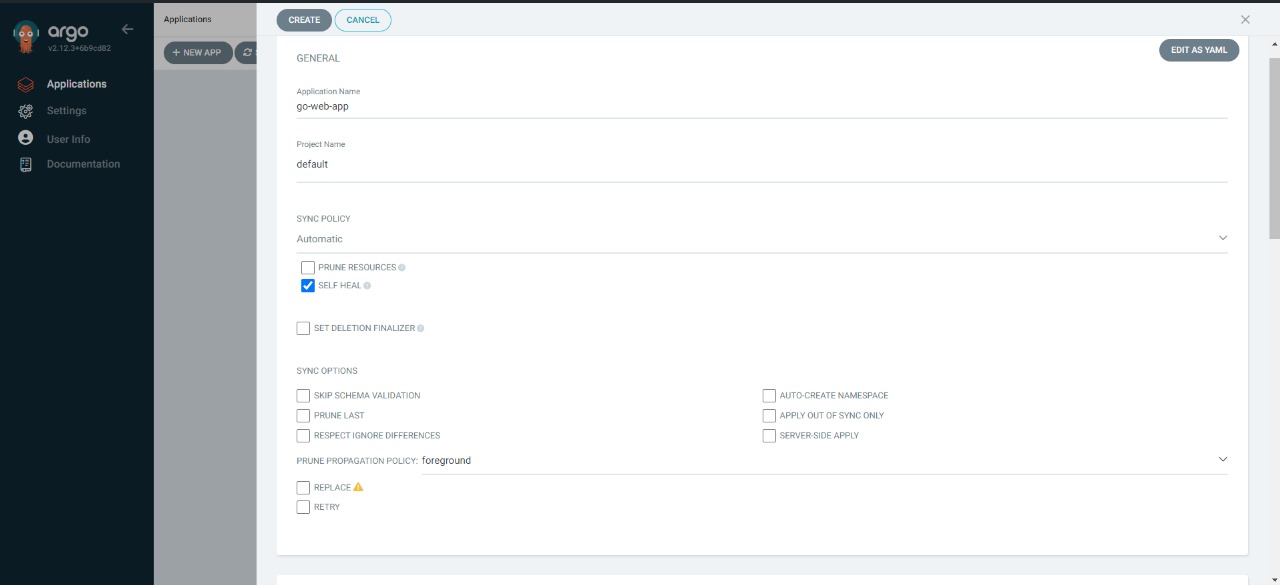
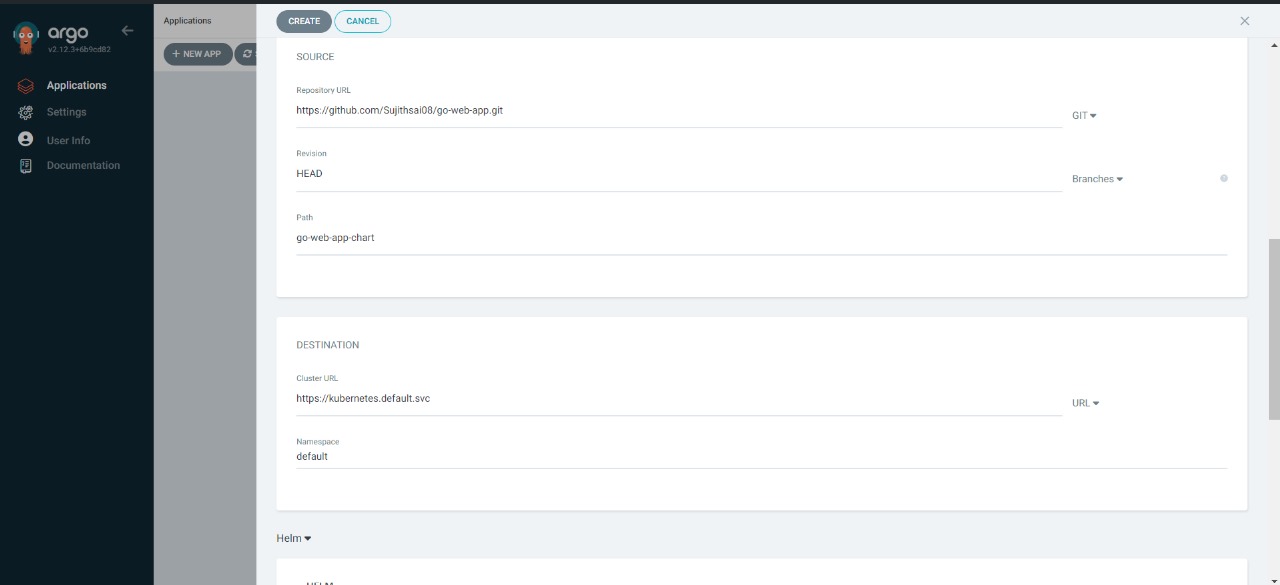
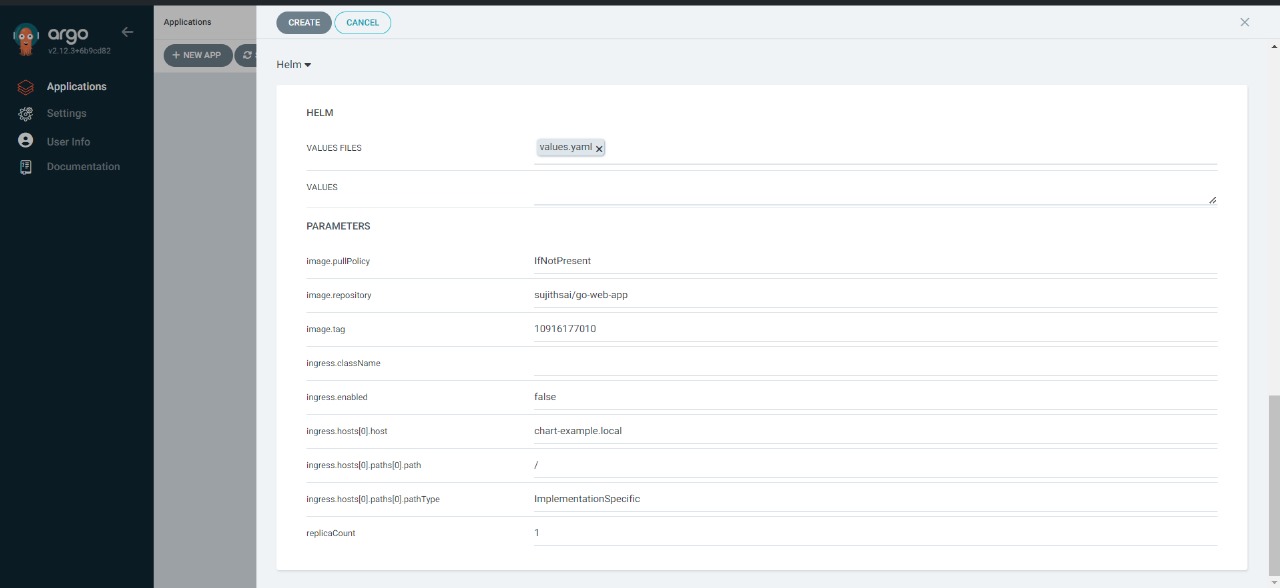
click on create.
Now verify whether argocd deployed our application on eks

access the application from the above address
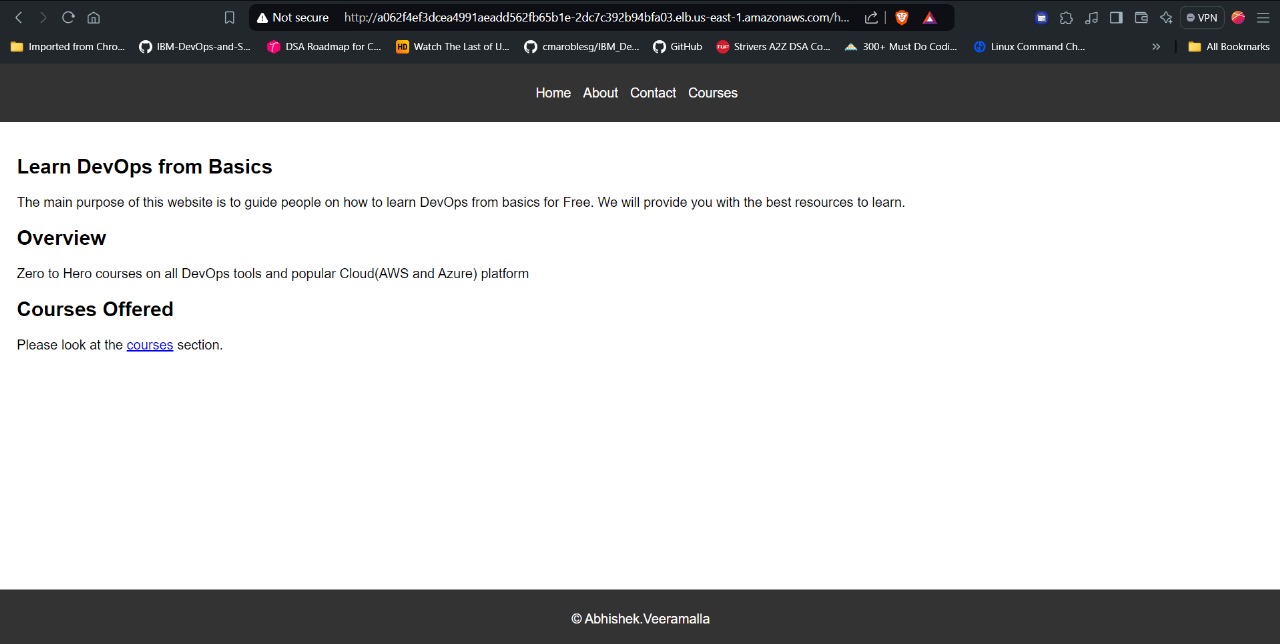
Now, let's verify that all the components are working correctly.
To do this, make a small change in the home.html file. Replace “Learn DevOps from basics” with “Go-web-app project by Sujithsai.”
The expected outcome is that when any changes are made to the files in the GitHub repository, the CI pipeline should be triggered. It should then execute all the stages automatically, including:
Checkout the code.
Build the application.
Push the Docker image to Docker Hub.
Update the “tag” in the
values.yamlfile.
All these steps should happen automatically as part of the CI process.
Lets edit home.html file as shown below
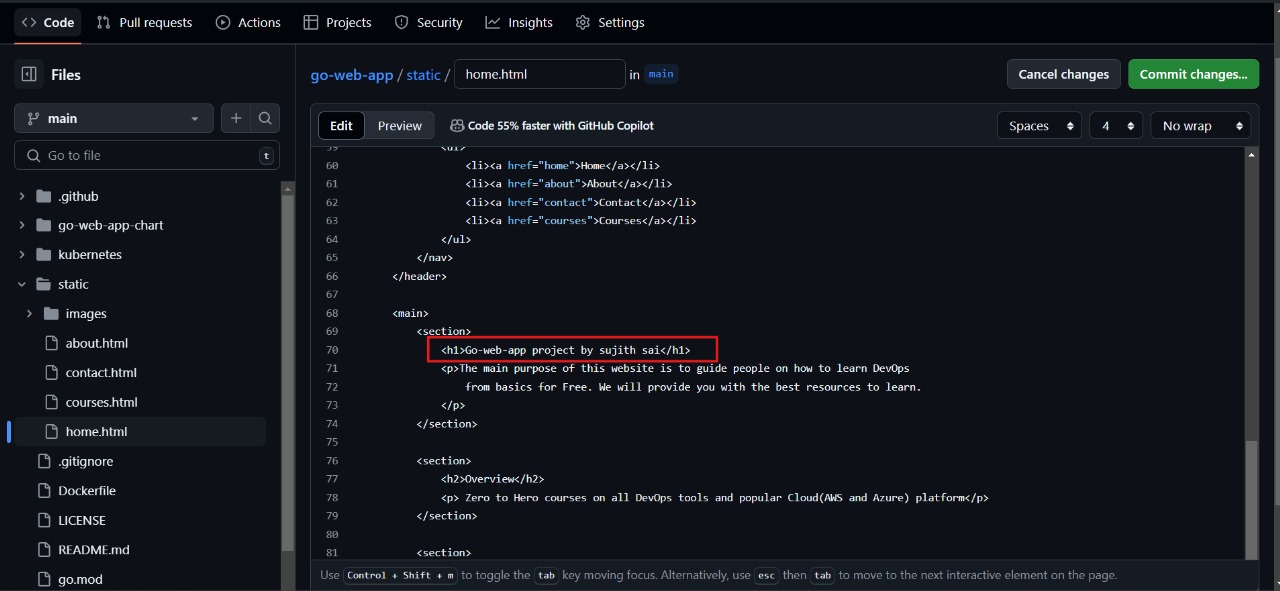
Verify continuous integration using GitHub Actions.
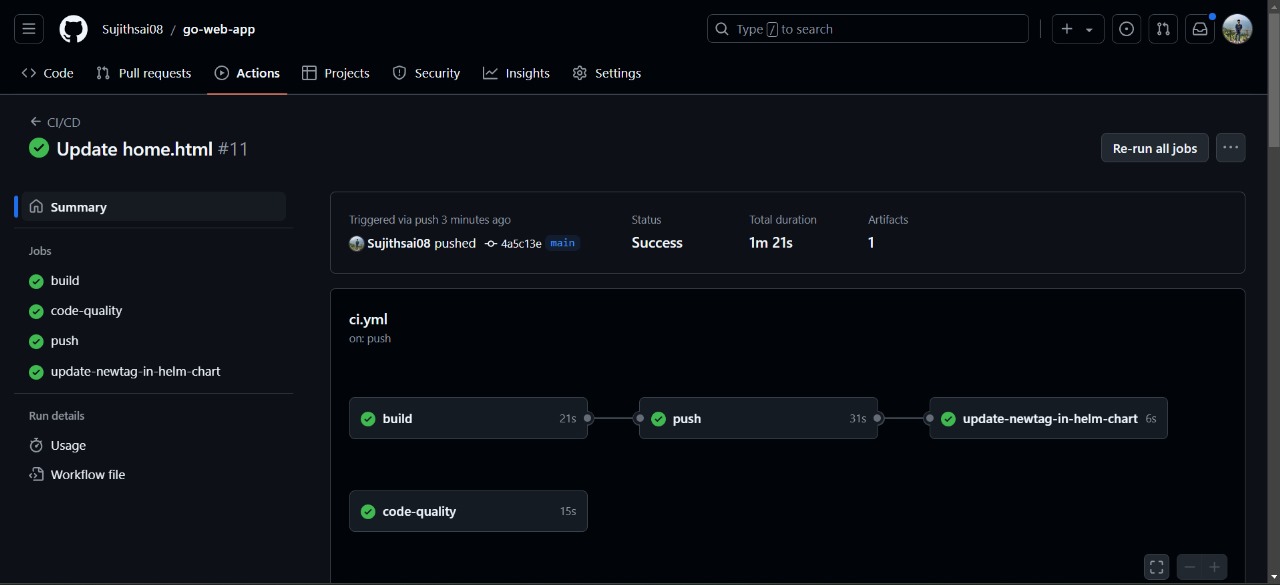
Verify the Docker image tag in Docker Hub.
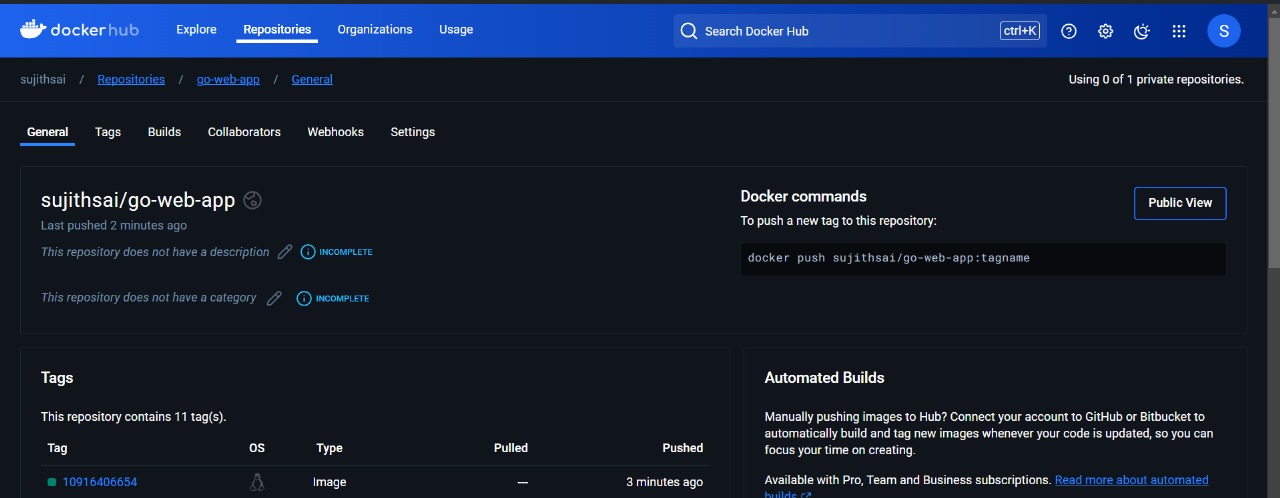
Verify the “tag” in the values.yaml file.
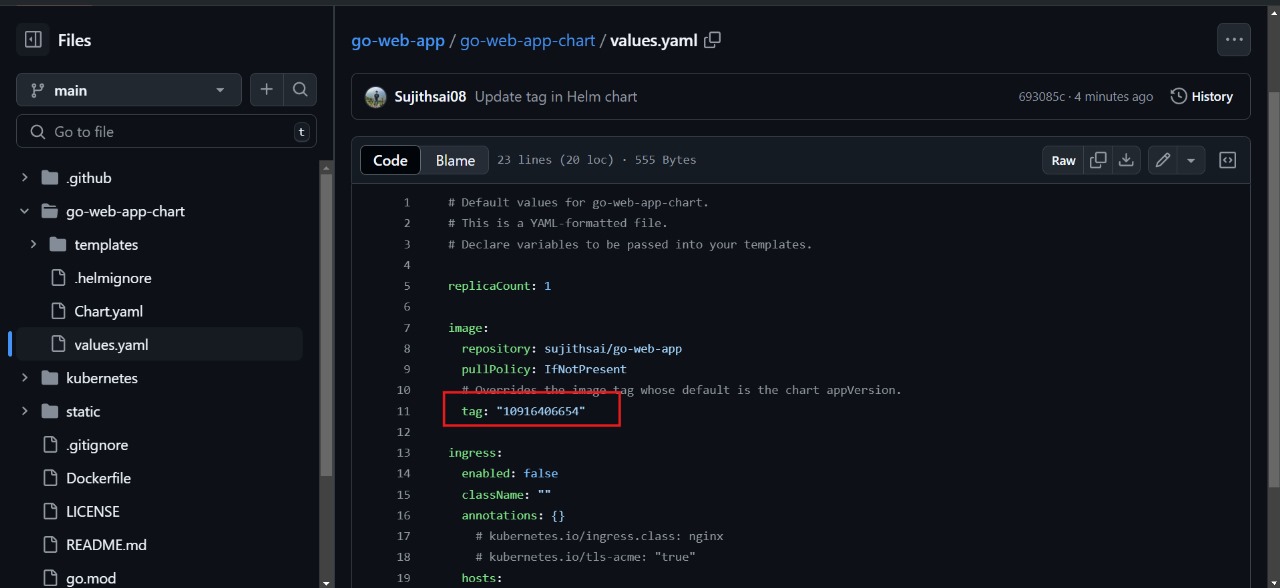
After the completion of the CI process, ArgoCD will monitor the repository for any changes. If changes are detected, it will automatically deploy the updated application to the desired Kubernetes cluster.
Let's go ahead and verify this behavior.
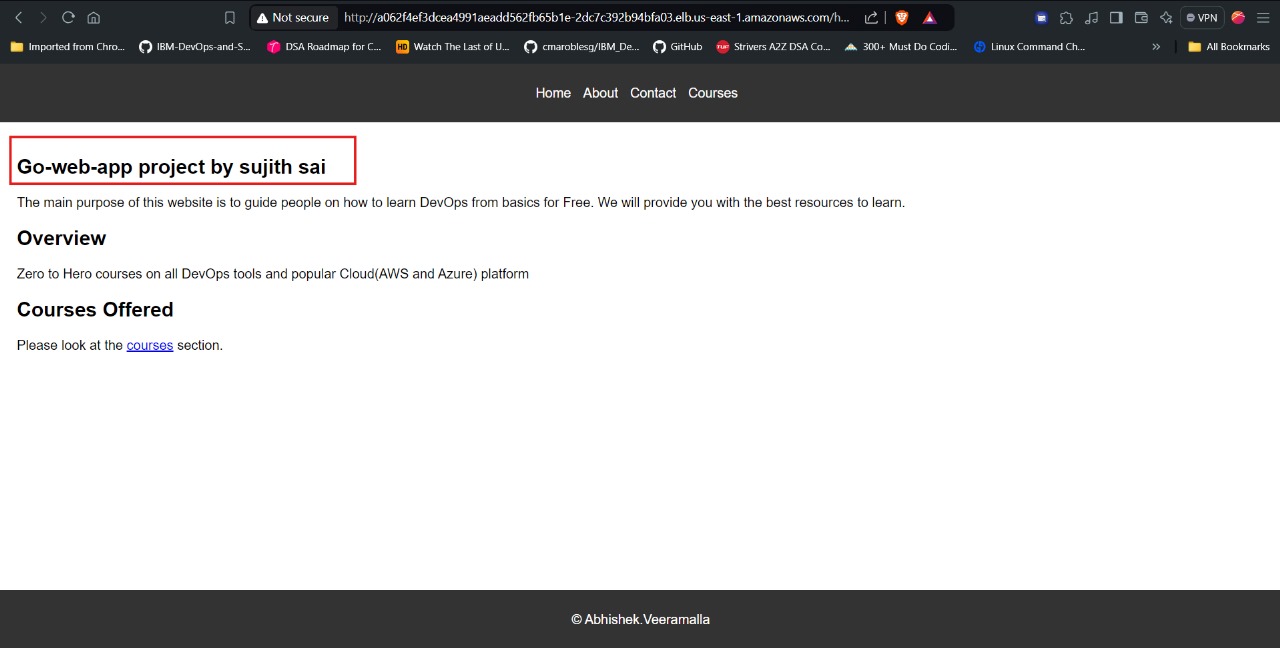
As you can see, the change has been automatically detected, updated, and deployed by ArgoCD.
Conclusion:
This project showcases the process of transforming a Go application into an automated, scalable deployment using modern DevOps practices. We containerized the app with a multi-stage Dockerfile, created Kubernetes manifests, and deployed it on an AWS EKS cluster. An Nginx ingress controller was set up for external access. Using a Helm chart, we enabled easy configuration and deployment across environments. GitHub Actions handled continuous integration, automating build, test, and deployment. Finally, we integrated ArgoCD for continuous delivery, streamlining the entire workflow.
Subscribe to my newsletter
Read articles from Sujith Sai directly inside your inbox. Subscribe to the newsletter, and don't miss out.
Written by
